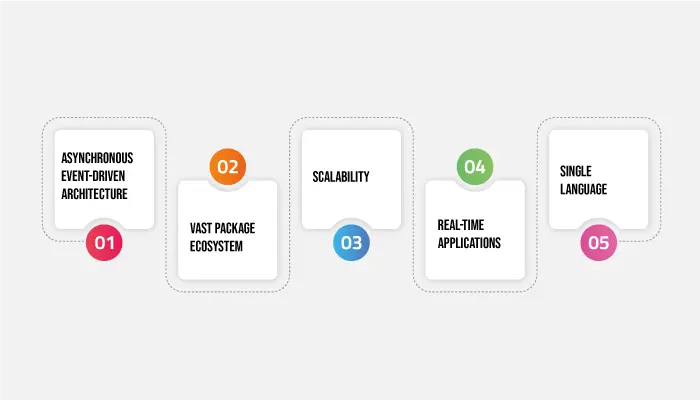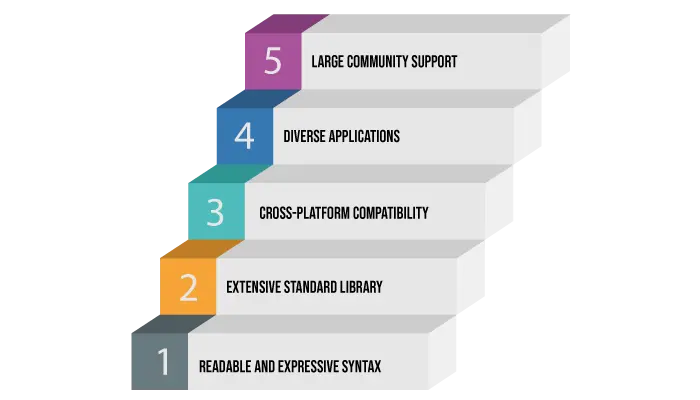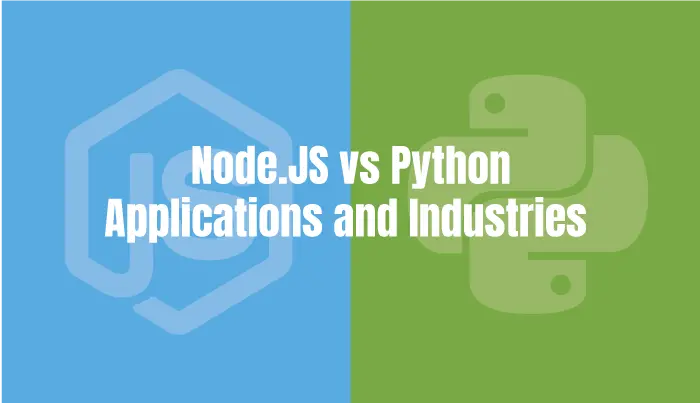Confused between Node.JS vs Python?
Well, you aren’t the only one.
When it comes to choosing the right runtime environment for your web applications or software projects, Node.js and Python are two popular contenders that often come to mind.
Node.js is renowned for its fast and scalable server-side capabilities, while Python is known for its simplicity, versatility, and extensive library support.
In this detailed comparison, we’ll delve into the features, pros and cons, performance, syntax, code examples, speed, learning curve, and more for both Node.js and Python, to help you make an informed decision.
Therefore, with this being said, let’s get right into it:
What is Node.JS?

Picture a runtime environment that ushers JavaScript—the language of the web—beyond the confines of browsers and into the realm of server-side applications.
This is where Node.js comes into play, offering you a dynamic and efficient platform to build robust and responsive applications.
At its core, Node.js is a JavaScript runtime built on the V8 engine by Google.
Whether you are building a chat application that thrives on instantaneous communication or an online gaming server that demands quick updates, Node.js empowers you to meet these challenges head-on.
As you immerse yourself in Node.js, you tap into a vast ecosystem of packages and modules through npm (Node Package Manager).
This abundance of resources simplifies development, allowing you to integrate third-party functionality seamlessly.
So, when you explore Node.js Development, remember that it’s your gateway to reimagining JavaScript—transforming it from a language confined to web browsers into a force that drives dynamic and engaging server-side applications.
Speaking of which, let’s look at the features of Node.JS in the section below.
Features of Node.JS

Node.js is an open-source JavaScript runtime built on the V8 JavaScript engine by Google. Its features include:
- Asynchronous Event-Driven Architecture: Node.js excels in handling concurrent connections, making it highly efficient for I/O-intensive applications.
- Vast Package Ecosystem: The npm (Node Package Manager) hosts a plethora of modules and libraries, enabling developers to easily integrate third-party functionality.
- Scalability: Node.js is designed to handle large-scale applications with ease, thanks to its non-blocking I/O model.
- Real-time Applications: Its event-driven nature makes it ideal for real-time applications such as chat applications, online gaming, and collaborative tools.
- Single Language: With Node.js, both the client-side and server-side can be written in JavaScript, reducing context-switching for developers.
Pros and Cons of Node.JS
Pros:
- High Performance: Node.js is known for its speed and efficiency, making it suitable for high-performance applications.
- Scalability: Its non-blocking architecture allows handling a large number of concurrent connections without slowing down.
- Extensive Community: Node.js has a vibrant community that contributes to the development of packages, tools, and resources.
Cons:
- Single–threaded: Being single-threaded, CPU-bound tasks can potentially block the event loop, affecting overall application performance.
- Callback Hell: Deeply nested callbacks can lead to readability and maintenance challenges, though modern approaches like Promises and async/await mitigate this.
- Lack of CPU–bound Performance: While Node.js is great for I/O-bound tasks, it might not be the best choice for CPU-intensive computations.
What is Python?

In your journey through the realm of programming languages, you’ll undoubtedly encounter Python, a versatile and expressive high-level programming language.
When you think of Python, imagine a language designed with you in mind—a language that prioritizes simplicity, readability, and an intuitive syntax.
Python is a scripting language that encapsulates power and elegance in its design.
Whether you are a newcomer to programming or a seasoned developer, you can find solace in Python’s clear and concise syntax.
Its “batteries included” philosophy ensures that essential functions and modules are readily available, minimizing the need to reinvent the wheel.
With Python, you can venture into various domains, from web development and data science to automation and machine learning.
Now, to better understand Node.JS vs Python, let’s look at this programming language’s Features.
Features of Python

Python is a versatile, high-level programming language known for its simplicity and readability. Its features include:
- Readable and Expressive Syntax: Python’s clean and readable syntax makes it an ideal choice for beginners and experienced developers alike.
- Extensive Standard Library: Python’s rich standard library reduces the need for third-party dependencies, offering solutions for various tasks.
- Cross-Platform Compatibility: Python code can run on multiple platforms with minimal adjustments, enhancing its portability.
- Diverse Applications: Python is used in web development, data analysis, artificial intelligence, scientific computing, automation, and more.
- Large Community Support: The Python community actively develops libraries and frameworks, offering solutions for diverse application domains.
Pros and Cons of Python
Pros:
- Readability: Python’s intuitive and clean syntax promotes readable code, reducing the learning curve and enhancing collaboration.
- Versatility: It supports both object-oriented and procedural programming paradigms, making it suitable for a wide range of projects.
- Vast Ecosystem: The Python Package Index (PyPI) hosts an extensive collection of packages, enabling rapid development.
Cons:
- Global Interpreter Lock (GIL): The GIL can restrict the performance of CPU-bound multi-threaded Python applications.
- Performance Overhead: Python’s interpreted nature can lead to slower execution speeds compared to compiled languages.
- Mobile Development: While possible, Python might not be the top choice for developing mobile applications due to limited frameworks.
Now with this out of the way, it’s time to compare Node.JS vs Python head to head in the section below.
Node.JS vs Python, Head-To-Head Comparison
It’s time to compare these two technologies head to head.
Python vs Node.JS is a long standing debate. And rightfully so. Well, in this section of the blog, we shall be comparing both of these platforms with each other in some major areas.
Therefore, with this being said, let’s get right into it:
Node.JS vs Python Performance

Node.js Performance
Node.js has redefined server-side development by bringing JavaScript—a language primarily known for browser interactions—to the backend.
Its performance shines in I/O-bound scenarios where applications need to handle a high volume of concurrent connections.
Node.js’ event-driven, non-blocking architecture leverages asynchronous callbacks to efficiently manage multiple requests simultaneously. This makes it ideal for real-time applications, like instant messaging and collaborative tools, where responsiveness and speed are paramount.
Python Performance
Python, often lauded for its versatility and simplicity, follows a more conventional approach to server-side development.
Its performance excels in CPU-bound tasks—such as scientific computations and data analysis—where computational power takes precedence over concurrent connections.
However, Python’s Global Interpreter Lock (GIL) has been a topic of debate. The GIL restricts Python from executing multiple threads concurrently, impacting the performance of multi-threaded CPU-bound applications.
Nevertheless, the use of external libraries and extensions can help mitigate this limitation.
Moving on, in next Node.JS vs python comparison, let’s compare syntax.
Node.JS vs Python Syntax

Node.js Syntax
Node.js, powered by JavaScript, employs a syntax that has evolved over time to accommodate the dynamic nature of web development.
Its syntax resonates with those who have experience in front-end web development, making the transition to server-side coding smoother for JavaScript enthusiasts.
The callback-based nature of asynchronous programming, while efficient, can lead to complex nesting and callback hell.
However, modern solutions like Promises and async/await have significantly improved code readability and maintainability.
Python Syntax
Python boasts a syntax that’s renowned for its simplicity, elegance, and readability.
Its clean structure enhances code maintainability, reduces the likelihood of errors, and accelerates the development process.
The language’s Zen of Python philosophy emphasizes readability, making it an excellent choice for beginners and seasoned developers alike.
Python development’s syntax encourages python developers to write code that reads like English sentences, fostering better communication and collaboration within development teams.
Node.JS vs Python Code Example: Building Basic HTTP Server
Node.js Example
Here’s a simple Node.js code snippet that sets up an HTTP server to respond with “Hello, Node.js!” to incoming requests
“const http = require(‘http’);
const server = http.createServer((req, res) => {
res.writeHead(200, {‘Content-Type’: ‘text/plain’});
res.end(‘Hello, Node.js!’);
});
server.listen(3000, () => {
console.log(‘Server is running on port 3000’);
});”
Python Example:
In Python, you can achieve a similar result using the built-in http.server module:
“from http.server import BaseHTTPRequestHandler, HTTPServer
class MyHandler(BaseHTTPRequestHandler):
def do_GET(self):
self.send_response(200)
self.send_header(‘Content-type’, ‘text/plain’)
self.end_headers()
self.wfile.write(b’Hello, Python!’)
server = HTTPServer((‘localhost’, 3000), MyHandler)
print(‘Server is running on port 3000’)
server.serve_forever()”
In these examples, you can see the distinctive syntax and programming paradigms of Node.js vs Python.
Node.js leverages the http module, whereas Python utilizes http.server.
These samples provide a glimpse into the core structures of both languages and their respective approaches to handling HTTP requests.
Node.JS vs Python Speed

Node.js Speed and Efficiency
Node.js is designed with a focus on performance.
Its asynchronous, non-blocking architecture allows it to efficiently manage multiple concurrent connections, making it particularly well-suited for applications that demand real-time interactions.
Moreover, Node.JS vs Python Benchmarks often highlight Node.js’ impressive event-loop mechanism, showcasing its ability to handle thousands of simultaneous connections with relatively low resource usage.
However, it’s important to note that Node.js might not be the optimal choice for CPU-bound tasks due to its single-threaded nature.
Python Speed and Efficiency
Python’s interpreted nature can lead to performance overhead compared to compiled languages.
However, this doesn’t mean Python is inherently slow.
Python’s performance can be significantly improved through various methods, such as using compiled extensions (Cython) for critical sections of code.
For CPU-bound tasks, Python’s performance can rival that of many other languages.
Moreover, Python’s extensive ecosystem and support for multi-threading and multiprocessing make it adaptable for various performance scenarios.
Node.JS vs Python Learning Curve

Node.js Learning Curve
For developers already familiar with JavaScript, especially those who have worked on front-end development, transitioning to Node.js can be relatively smooth.
The fundamental principles of JavaScript carry over to Node.js, and the ability to use a single language across the stack can streamline development.
However, the learning curve might steepen when dealing with asynchronous programming paradigms and understanding how the event loop operates.
Novices to JavaScript might need time to grasp the intricacies of callbacks, Promises, and async/await.
Python Learning Curve
Python is often lauded for its gentle learning curve, making it an excellent choice for both beginners and experienced developers.
Its readability and concise syntax contribute to a shorter learning curve, enabling new developers to start building functional applications quickly.
The extensive documentation and active community support further ease the learning process. However, the depth of Python’s capabilities means that more complex concepts can still be explored as developers progress.
Node.JS vs Python Applications and Industries

Node.js Applications and Industries
Node.js is a powerhouse when it comes to real-time applications.
Its asynchronous nature and event-driven architecture make it a go-to choice for building interactive web applications, live streaming platforms, online gaming servers, and instant messaging apps. And Node.JS libraries make it that much better.
Companies like Netflix and LinkedIn have harnessed Node.js to deliver real-time updates and scalable user experiences.
In addition to this, Node.js is an excellent fit for microservices architectures, thanks to its lightweight nature and efficient handling of numerous connections.
Python Applications and Industries
Python’s versatility lends itself to a wide array of applications and industries.
In data science and machine learning, Python shines with libraries like NumPy, pandas, and scikit-learn.
Scientific computing, simulations, and modeling also benefit from Python’s robust ecosystem.
Python’s simplicity makes it a favorite for web development, especially when coupled with frameworks like Django and Flask.
The language is also heavily used in automation, scripting, and backend development. Companies like Google, Instagram, and Dropbox leverage Python for various parts of their technology stacks.
Node.JS vs Python, How To Choose The Right One

Confused whether to hire Python developer or hire Node.JS Developers
Well, that’s what Node.JS vs Python does. But worry not, we will be discussing whether you shpuld go with python or Node.Js.
Therefore, let’s get right into it:
Choose Node.js if:
- To build real-time applications like chat applications or online games.
- Application requires handling a high number of concurrent connections.
- Already familiar with JavaScript and want to use it on the server side.
- Need a scalable solution for I/O-bound tasks.
Choose Python if:
- Value code readability and maintainability.
- Project involves data analysis, scientific computing, or machine learning.
- Developing web applications that don’t require handling an extreme number of concurrent connections.
- You’re aiming for a versatile language that can be used across various domains.
Choosing Your Path: A Step-by-Step Guide
Let’s see how to whether you should go with JavaScript developers or one of the Python Development Companies.
Here are some things that you need to consider:
Project Requirements
Begin by understanding your project’s specific needs. Does it require real-time interactions, scalability, or high-performance computations? Identify the primary challenges your application needs to overcome.
Team Expertise
Consider the proficiency of your development team with JavaScript and Python. If your team is already well-versed in one of the languages, it could be an advantage to leverage their existing skills.
Domain and Industry
Evaluate the industry your project belongs to. For example, if you’re building a data-driven application, Python’s data science capabilities might be indispensable. Similarly, if you’re focusing on real-time interactions, Node.js could be the ideal choice.
Scalability
Consider the anticipated user load and concurrent connections your application needs to handle. Node.js is well-suited for high concurrency scenarios, while Python’s sweet spot lies in its versatility.
Performance Balance
Determine whether your application is primarily I/O-bound or CPU-bound. Node.js excels in I/O-bound tasks, while Python can achieve impressive performance in CPU-bound tasks through optimized code and compiled extensions.
Ecosystem and Libraries
Explore the libraries and frameworks available for both languages that align with your project’s needs. Python’s wide-ranging ecosystem and Node.js’ vibrant npm repository offer valuable resources.
Future Growth
Consider the long-term perspective. Will your chosen language and runtime environment continue to support your project’s growth and evolving requirements?
Conclusion
In the dynamic world of software development, choosing the right runtime environment is a pivotal decision. Both Node.js vs Python offer distinct advantages that cater to different use cases and preferences. But at the end of the day, it depends on your project needs. In any case, for more detailed on the same, you should consult a professional development firm.
FAQ
Yes, Node.js excels in real-time scenarios like chat apps and gaming servers due to its asynchronous architecture.
Python’s strength lies in its versatility, readability, and extensive library support for diverse domains.
Yes, Node.js brings JavaScript to the server-side, allowing you to use a consistent language across your application.
Python is the preferred choice for data science due to its rich ecosystem of data analysis libraries.
Yes, Node.js is single-threaded, but its event-driven architecture allows it to handle many concurrent connections efficiently.
Python can be slower in certain scenarios due to its interpreted nature, but optimized code and compiled extensions can enhance performance.
Python can perform well in CPU-bound tasks with optimized code and compiled extensions, while Node.js is better for I/O-bound tasks.
Python has a gentler learning curve with its readable syntax, making it suitable for beginners and experienced developers.
Yes, both can build web apps. Node.js offers real-time features, while Python is known for simplicity and extensive frameworks.
Both have active communities, with Node.js thriving in web development and Python spanning diverse domains like data science and automation.

Niketan Sharma is the CTO of Nimble AppGenie, a prominent website and mobile app development company in the USA that is delivering excellence with a commitment to boosting business growth & maximizing customer satisfaction. He is a highly motivated individual who helps SMEs and startups grow in this dynamic market with the latest technology and innovation.
Table of Contents




No Comments
Comments are closed.